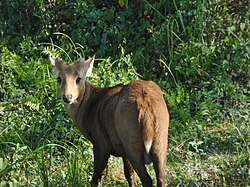Hog Deer
| Indian Hog Deer | |
|---|---|
 |
|
| Hog deer (A. p. porcinus) at Manas National Park | |
| Scientific classification | |
| Kingdom: | Animalia |
| Phylum: | Chordata |
| Class: | Mammalia |
| Order: | Artiodactyla |
| Family: | Cervidae |
| Subfamily: | Cervinae |
| Genus: | Hyelaphus |
| Species: | H. porcinus |
| Binomial name | |
|
Hyelaphus porcinus Zimmermann, 1780 |
|
The Indian hog deer (Hyelaphus porcinus) is a small deer whose habitat ranges from Pakistan, through northern India, to mainland southeast Asia, which inhabits much of the Indo-Gangetic Plains of Pakistan, northern India, Nepal, Bangladesh, southwestern Yunnan Province in China, all the way to western Thailand. Introduced populations also exist in Australia and Sri Lanka.
It gets its name from the hog-like manner in which it runs through the forests with its head hung low so that it can duck under obstacles instead of leaping over them like most other deer. Cover is taken as soon as it is feasible. During flight, the tail is held erect, showing the white underside.
A mature hog deer stag stands about 70 cm at the shoulder and weighs approximately 50 kg while hinds are much smaller, standing about 61 cm and weighing in the vicinity of 30 kg. They are very solidly built with a long body and relatively short legs and the line of the back slopes upward from the shoulders to a high rump. The ears are rounded; older animals tend to become light coloured in the face and neck.
The Indian Hog Deer's coat is quite thick and generally a uniform dark-brown in winter except for the underparts of the body and legs which are lighter in colour. During late spring, the change to a summer coat of rich reddish brown commences although this may vary between individuals. Many hog deer show a dark dorsal stripe extending from the head down the back of the neck and along the spine. In summer, there is usually a uniform row of light-coloured spots along either side of the dorsal stripe from the shoulders to the rump. The tail is fairly short and brown but tipped with white. The underside of the tail is white and the deer can fan the white hairs out in a distinctive alarm display.
Indian hog deer have preorbital glands on the face just below the eyes and metatarsal glands located high on the side of the rear legs. Pedal glands are located between the cleaves or toes of the hind hooves.
The antler of a mature hog deer stag is typically three tined-brow tine with solid main beam terminating in inner and outer top tines. However, antlers with more points are not uncommon. The distinctive features of typical hog deer antlers are the acute angle between the brow tine and main beam and the fact that the inner tops tend to be short and angle back from the main beam and across towards the opposite antler.
...
Wikipedia

